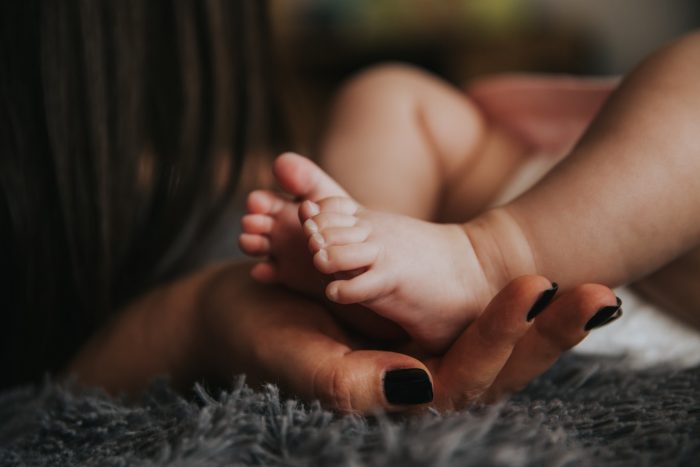Our Journey Through Infant Eczema Hell.
Everyone has their one product they swear by for child rearing: gripe water, swaddle blankets, amber teething necklaces. With eczema it is the same.
Our daughter’s cradle cap started to fade at five months and small patches of eczema began to appear on her legs and gradually everywhere but her diaper area.
At eight months, short of animal sacrifice we had tried everything: an elimination diet from hell (as I was still breastfeeding)—weeks of no dairy, gluten, then eating only brown rice, lamb and squash. We tried a chiropractor, acupuncturist, steroid ointments, antibiotics, antibiotic ointment, antihistamines, Benadryl®, prayer, bacon grease, emu oil, salt baths, bleach baths, coconut oil, shea butter, cocoa butter, melaluca lotion (tea tree oil), aloe and yes, we even tried Aveeno®, Aquaphor® and all of the other carcinogenic petroleum products. We used only natural detergent, then no detergent, only cotton (could she be allergic to cotton?) natural soaps, no soap, carcinogenic soaps etc.
We were just surviving by swaddling Aurélia and keeping her hands in socks so she couldn’t scratch her face raw, especially at night. This was the most stressful time of my life. Every Facebook status update or outing to the store meant some well meaning person would invariably ask “OH yes, my ____ had that too, have you tried Aveeno®?”
I began to avoid social situations and on reflex was automatically reaching out to gently bat my daughter’s hand away from her wounds.
Aurélia’s blood test revealed only a dairy allergy. I avoided all dairy for months and there was no change. I am also prone to eczema.
Ready to take a frying pan to our baby, our doctor recommended seeing a pediatric eczema specialist at National Jewish Health in Denver.
The staff at National Jewish Health were nothing short of amazing, having seen worse infant eczema on a regular basis I was confident we were in good hands. I learned only 6% of eczema is caused by food allergies and the good news is that, time is on our side since most infants outgrow their eczema.
The doctor was extremely patient with all of my questions, Dr. Searing was even taking notes from me! I felt gratified and reassured that our daughter was still happy and thriving despite her handicap, our struggle was worth it.
It is here we were schooled in a treatment that is so basic and effective and yet overlooked on the interwebz I am compelled to share the technique that has finally helped me live a sane life as we manage my daughters eczema. Introducing *drumroll* The Wet Dressings.
Our daughter’s diaper area was the smoothest and most rash free area on her body, which was a good indicator the wet dressings would help her since it is sort of like creating a full body diaper.
If you run your hand over a patch of eczema it feels dry, the idea is to put moisture back into the skin. We had read about short baths, or going weeks without baths, Dr. Searing told us that 15 minutes of soaking is the minimum amount of time it takes water to penetrate the skin. But on the National Eczema Association‘s website they give instructions for wet dressings saying to soak for 5 minutes—this is incorrect and misleading, then again I guess you can’t expect much from a website that automatically plays elevator music on their homepage—I thought that died with Myspace? I digress, wet dressings are AMAZING! Here is how to do them:
Morning: 15-20 minute warm (not hot) bath with a lot of splashing—I made a 15 minute playlist on my Ipod so I would know when our time was up and bought lots of toys for entertainment, followed by ointment application within three minutes of exiting the water—this is crucial. We were advised to use a gentler steroid called Desonide 0.5% that does not have the scary side effects of cortisone and has been proven very safe for infants. Ointments are oil based so they penetrate the skin more effectively than lotions.
Run a snug fitting long sleeve top and pair of pants under warm water and ring out so they are still wet but not sopping. Apply the wet clothes. Wet socks may be used on the hands and feet if these areas are affected (in extreme cases wet bandages can be used around the face—even though we had some areas on the face, we did not use bandages and the wet dressings put so much moisture back into her skin that in a few days her face healed on its own).
Take dry clothes and socks and place them over the wet clothing and socks. Thus sealing in the ointment and moisture. We noticed a difference within a few days.
We left the wet/dry dressings on for an hour in the morning, then did them right before bedtime and kept them on all night with an extra blanket on top for 7 days. After 7 days of this treatment I barely recognized my daughter, her skin was soft and she was no longer too busy scratching to discover new things. It is important not to do the wet dressings too much longer than a week because it can put so much moisture in the skin it can actually create yeast/fungus.
At 13 months old, her eczema hasn’t completely disappeared but it’s more of a side note than a headline. With daily 15 minute baths, 0.5% Desonide ointment (which requires a prescription, we go through two 60g tubes a month) after the baths and melalulca lotion for in between times, vitamin D drops and probiotics, we are managing quite well. When the temperature cools here I will do another week of wet dressings to help give her skin another boost of moisture and peace for both of us.











Read 21 comments and reply